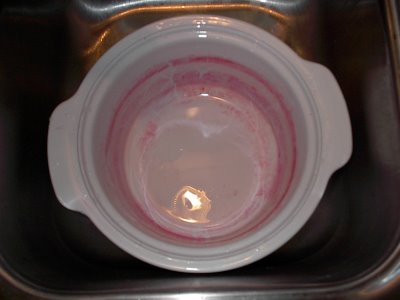How to make a skein? First unwind it into a big loop, like you see here:

The size of the loop to be made is sorta tricky; if you're doing solid, one-color dyeing, it doesn't matter. But if you're doing a variegated like I did, the length of the loop determines the length of the color repeat. Beyond that information, all I can say is, experiment. I haven't quite figured out all the details, myself. (I want to find a way to do Noro-style color repeats WITHOUT getting food color on the ceiling, the cat, the walls, or the husbeast. I may have to take that to the back yard and the gas grill, next summer.)
After the yarn is 'looped', tie the beginning and end together. Then use some waste yarn (I suggest cotton, or something else there's no chance of felting) to make little figure-eights through the yarn. Under-and-over through the threads two or three times, then come back across the other way, and tie the two ends together. If you've ever bought hand-dyed yarns, you'll have removed these from it before rolling it into a ball. Here's the only photo I took of mine (I can't find any better pictures on the 'net, sorry):
The yellow is the waste yarn. You can click on the photo to make it larger.
I suggest putting in one of those ties every foot and a half/half meter or so; they're all that stand between you and disaster. (In the form of a snarled mess. My ties were about a yard/meter apart and I barely survived without a two-hour untangling session.) On the other hand, make sure they're fairly loose, so that you don't tie-dye your yarn by accident.
The crock-pot looked like this when I was finished:
I dumped in a little bleach and swished that around with a paper towel, then scrubbed down the whole thing with dish soap and hot water and it's perfectly fine now. (There is, however, a flourescent pink wooden spoon. It's safe to cook with, though.) If you're going shopping for a crock-pot expressly for this purpose, I strongly recommend getting one with a removable liner like this (a ceramic or corning-ware pot that fits inside the metal heater casing). It makes clean-up SO much easier. I'm almost disappointed the thing came clean; I hate my crock-pot for cooking and have been half-heartedly trying to destroy it for a while now, so I can buy a new one. (This attitude, that I can't buy new with a working one already, is entirely my father's fault. I come by the cheapskate thing naturally.)
Incidentally, if you're doing a two-color job like I did, you need to do a bleach scrub BETWEEN the colors. This seems really obvious in retrospect. But I didn't, and the blue picked up pink from the sides of the crock-pot, and became an odd, variegated blue-purple streaked. I rather like it, but I wasn't going for any effect in particular - the whole thing was an experiment. If I'd been shooting for perfect blue I'd have had a hissy fit. Or a martini.
So, no green eggs and ham for the husbeast. (Though if he continues watching Band of Brothers with the baby in the living room, green pot-roast may be the least of the things he has to worry about from me.)
And I'd love to upload the photo I took today of the baby stuck in her pile of toys, but Blogger is fucking with me again. Maybe tomorrow.













1 comment:
brilliant Julie! Thanks! Fabulously fast response. So glad I asked now.
I have a crockpot with a black container. So it'll never show up the stains until my chicken turns green, I imagine. LOL!
Hey, what are your thoughts on dying something that's already been knit?
Post a Comment